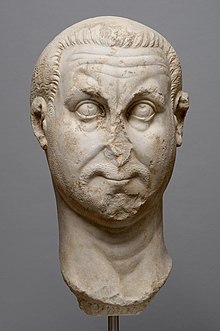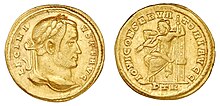Licinius
| Licinius | |||||
|---|---|---|---|---|---|
 Colossal portrait head of Licinius from theKunsthistorisches Museum,Vienna[1] | |||||
| Roman emperor | |||||
| Reign | 11 November 308 –19 September 324 | ||||
| Predecessor | Severus II | ||||
| Successor | Constantine I(alone) | ||||
| Alongside | Galerius(East,308–311) Constantine I (West,308–324) Maximinus Daza(311–313) Valerius Valens(316–317) Martinianus(324) | ||||
| Born | Licinius Licinianus (?)[2] c. 265[3] MoesiaSuperior,Roman Empire | ||||
| Died | Spring of 325 (aged around 60) Thessalonica | ||||
| Spouse | Flavia Julia Constantia | ||||
| Issue | Licinius II | ||||
| |||||
| Religion | Ancient Roman religion | ||||
Valerius Licinianus Licinius(Greek:Λικίνιος; c. 265 – 325) wasRoman emperorfrom 308 to 324. For most of his reign, he was the colleague and rival ofConstantine I,with whom he co-authored theEdict of Milanthat granted official toleration to Christians in the Roman Empire. He was finally defeated at theBattle of Chrysopolis(AD 324), and was later executed on the orders of Constantine I.
Early reign[edit]
Born to aDacian[3][4]peasant family inMoesiaSuperior, Licinius accompanied his close childhood friend and future emperorGalerius,on the Persian expedition in 298.[3]He was trusted enough by Galerius that in 307 he was sent as an envoy toMaxentiusinItalyto attempt to reach some agreement about the latter's illegitimate political position.[3]Galerius then trusted the eastern provinces to Licinius when he went to deal with Maxentius personally after the death ofSeverus II.[5]
Upon his return to the east Galerius elevated Licinius to the rank ofAugustusin the West on 11 November 308, and under his immediate command were the Balkan provinces ofIllyricum,ThraceandPannonia.[4]In 310 he took command of the war against theSarmatians,inflicting a severe defeat on them.[6]On the death of Galerius in May 311,[7]Licinius entered into an agreement withMaximinus Dazato share the eastern provinces between them. By this point, not only was Licinius the officialAugustusof the west but he also possessed part of the eastern provinces as well, as theHellespontand theBosporusbecame the dividing line, with Licinius taking the European provinces and Maximinus taking the Asian.[4]
An alliance between Maximinus and Maxentius forced the two remaining emperors to enter into a formal agreement with each other.[5]So, in March of 313, Licinius marriedFlavia Julia Constantia,half-sister ofConstantine I,[citation needed]atMediolanum(now Milan); they had a son,Licinius the Younger,in 315. Their marriage was the occasion for the jointly-issued "Edict of Milan"that reissued Galerius' previous edict allowingChristianity(and any religion one might choose) to be professed in the Empire,[4]with additional dispositions that restored confiscated properties to Christian congregations and exempted Christian clergy from municipal civic duties.[8]The redaction of the edict as reproduced byLactantius– who follows the text affixed by Licinius inNicomediaon 14 June 313, after Maximinus' defeat – uses neutral language, expressing a will to propitiate "any Divinity whatsoever in the seat of the heavens".[9]



Daza in the meantime decided to attack Licinius. Leaving Syria with 70,000 men, he reachedBithynia,although the harsh weather he encountered along the way had gravely weakened his army. In April 313, he crossed theBosporusand went toByzantium,which was held by Licinius' troops. Undeterred, he took the town after an eleven-day siege. He moved to Heraclea, which he captured after a short siege, before moving his forces to the first posting station. With a much smaller body of men, possibly around 30,000,[12]Licinius arrived atAdrianoplewhile Daza was still besiegingHeraclea.Before the decisive engagement, Licinius allegedly had a vision in which an angel recited him a generic prayer that could be adopted by all cults which Licinius then repeated to his soldiers.[13]On 30 April 313, the two armies clashed at theBattle of Tzirallum,and in the ensuing battle Daza's forces were crushed. Ridding himself of the imperial purple and dressing like a slave, Daza fled toNicomedia.[5]Believing he still had a chance to come out victorious, Daza attempted to stop the advance of Licinius at theCilician Gatesby establishing fortifications there. Unfortunately for Daza, Licinius' army succeeded in breaking through, forcing Daza to retreat toTarsus,where Licinius continued to press him on land and sea. The war between them ended only with Daza's death in August 313.[4]
Licinius sought out and killed multiple relatives of the Tetrarchs - Daza’s wife and two children, Severus’ sonFlavius Severianus,Galerius’ sonCandidianus,Diocletian’s wifePriscaand daughterValeria,who was also Galerius’ wife.[14]
Given that Constantine had already crushed his rival Maxentius in 312, the two men decided to divide the Roman world between them. As a result of this settlement, theTetrarchywas replaced by a system of two emperors, calledAugusti:Licinius becameAugustusof the East, while his brother-in-law, Constantine, becameAugustusof the West.[7]
After making the pact, Licinius rushed immediately to the East to deal with another threat, an invasion by the PersianSassanid Empire.[5]
Conflict with Constantine I[edit]
In 314, a civil war erupted between Licinius and Constantine, in which Constantine used the pretext that Licinius was harbouring Senecio, whom Constantine accused of plotting to overthrow him.[5]Constantine prevailed at theBattle of CibalaeinPannonia(8 October 314).[4]Although the situation was temporarily settled, with both men sharing theconsulshipin 315, it was but a lull in the storm. The next year a new war erupted, when Licinius namedValerius Valensco-emperor, only for Licinius to suffer a humiliating defeat on the plains in theBattle of Mardia(also known as the Battle of Campus Ardiensis) inThrace.The emperors were reconciled after these two battles and Licinius had his co-emperor Valens killed.[4]
Over the next ten years, the two imperial colleagues maintained an uneasy truce.[5]Licinius kept himself busy with a campaign against the Sarmatians in 318,[4]but temperatures rose again in 321 when Constantine pursued some Sarmatians, who had been ravaging some territory in his realm, across the Danube into what was technically Licinius's territory.[4]When he repeated this with another invasion, this time by theGothswho were pillagingThraceunder their leaderRausimod,Licinius complained that Constantine had broken the treaty between them.
Constantine wasted no time going on the offensive. Licinius's fleet of 350 ships was defeated by Constantine's fleet in 323. Then in 324, Constantine, tempted by the "advanced age and unpopular vices"[7][5]of his colleague, again declared war against him and having defeated his army of 165,000 men[15]at theBattle of Adrianople(3 July 324), succeeded in shutting him up within the walls ofByzantium.[7][4]The defeat of the superior fleet of Licinius in theBattle of the HellespontbyCrispus,Constantine's eldest son andCaesar,compelled his withdrawal toBithynia,where a last stand was made; theBattle of Chrysopolis,nearChalcedon(18 September),[7]resulted in Licinius' final submission.[5]In this conflict Licinius was supported by the Gothic princeAlica.Due to the intervention of Flavia Julia Constantia, Constantine's sister and also Licinius' wife, both Licinius and his co-emperorMartinianwere initially spared, Licinius being imprisoned inThessalonica,Martinian inCappadocia;however, both former emperors were subsequently executed. After his defeat, Licinius attempted to regain power with Gothic support, but his plans were exposed, and he was sentenced to death. While attempting to flee to the Goths, Licinius was apprehended atThessalonica.Constantine had him hanged, accusing him of conspiring to raise troops among the barbarians.[5][16]
Character and legacy[edit]

As part of Constantine's attempts to decrease Licinius's popularity, he actively portrayed his brother-in-law as a pagan supporter. This may not have been the case; contemporary evidence tends to suggest that he was at least a committed supporter of Christians at one point.[citation needed]He co-authored the Edict of Milan which ended theGreat Persecution,and re-affirmed the rights of Christians in his half of the empire. He also added the Christian symbol to his armies, and attempted to regulate the affairs of the Church hierarchy just as Constantine and his successors were to do. His wife was a devout Christian.[18]
It is possibile that he converted.[19]However,Eusebius of Caesarea,writing under the rule of Constantine, charges him with expelling Christians from the Palace and ordering military sacrifices to pagan gods, as well as interfering with the Church's internal procedures and organization.[20]It has been theorized that he originally supported Christians along with Constantine, but later in his life turned against them and to paganism.[19]
Finally, on Licinius's death, his memory was branded with infamy; his statues were thrown down; and by edict, all his laws and judicial proceedings during his reign were abolished.[5]Such official erasure from the public record has come to be calleddamnatio memoriae.
Family tree[edit]
|
(See also:Chronological scheme of the Tetrarchy, 286–324)
| |||||||||||||||||||||||||||||||||||||||||||||||||||||||||||||||||||||||||||||||||||||||||||||||||||||||||||||||||||||||||||||||||||||||||||||||||||||||||||||||||||||||||||||||||||||||||||||||||||||||||||||||||||||||||||||||||||||||||||||||||||||||||||||||||||||||||||||||||||||||||||||||||||||||||||||||||||||||||||||||||||||||||||||||||||||||||||||||||||||||||||||||||||||||||||||||||||||||||||||||||||||||||||||||||||||||||||||||||||||||||||||||||||||||||||||||||||||||||||||||||||||||||||||||||||||||||||||||||||||||||||||||||||||||||||||||||||||||||||||||||||||||||||||||||||||||||||||||||||||||||||||||||||||||||||||||||||||||||||||||||||||||||||||||||||||||||||
|
Notes:
Bibliography:
| |||||||||||||||||||||||||||||||||||||||||||||||||||||||||||||||||||||||||||||||||||||||||||||||||||||||||||||||||||||||||||||||||||||||||||||||||||||||||||||||||||||||||||||||||||||||||||||||||||||||||||||||||||||||||||||||||||||||||||||||||||||||||||||||||||||||||||||||||||||||||||||||||||||||||||||||||||||||||||||||||||||||||||||||||||||||||||||||||||||||||||||||||||||||||||||||||||||||||||||||||||||||||||||||||||||||||||||||||||||||||||||||||||||||||||||||||||||||||||||||||||||||||||||||||||||||||||||||||||||||||||||||||||||||||||||||||||||||||||||||||||||||||||||||||||||||||||||||||||||||||||||||||||||||||||||||||||||||||||||||||||||||||||||||||||||||||||
References[edit]
- ^http://laststatues.classics.ox.ac.uk, LSA-687 (J. Auinger)
- ^Craven, Maxwell (2019)."Licinius".The Imperial Families of Ancient Rome.Fonthill Media.ISBN978-1781557389.
- ^abcdeJones, A.H.M.; Martindale, J.R. (1971).The Prosopography of the Later Roman Empire, Vol. I: AD 260–395.Cambridge University Press. p. 509.
- ^abcdefghijDiMaio, Michael Jr. (23 February 1997)."Licinius (308–324 A.D.)".De Imperatoribus Romanis.
- ^abcdefghijGibbon, Edward(1776). "Chapter XIV".The History of the Decline and Fall of the Roman Empire.Vol. II.
- ^Lendering, Jona."Licinius".Livius.org.Archived fromthe originalon 11 September 2014.Retrieved26 March2020.
- ^abcdeOne or more of the preceding sentences incorporates text from a publication now in thepublic domain:Chisholm, Hugh,ed. (1911). "Licinius".Encyclopædia Britannica.Vol. 16 (11th ed.). Cambridge University Press. p. 587.
- ^Carrié, Jean-Michel; Rousselle, Aline (1999).L'Empire Romain en mutation: des Sévères à Constantin, 192–337.Paris: Éditions du Seuil. p. 228.ISBN2-02-025819-6.
- ^Lactantius,De Mort. Pers., ch. 48, cf. Internet History Sourcebooks Project, Fordham University,[1].Accessed 31 July 2012
- ^Duruy, Victor (1886).History of Rome: And of the Roman People, from Its Origin to the Invasion of the Barbarians.Dana, Estes & Company.
- ^"Oeuvre: Précisions – camée," Triomphe de Licinius "(camée.308) | catalogue".Département des monnaies, médailles et antiques | BnF – Site institutionnel(in French).Retrieved30 June2024.
- ^Kohn, George Childs,Dictionary Of Wars, Revised Edition,p. 398.
- ^Carrié & Rousselle,L'Empire Romain en Mutation,p. 229
- ^Barnes 1981,p. 64.
- ^Grant p. 46
- ^Grant, pp. 47–48
- ^British Museum Collection
- ^Peter J. Leithart,Defending Constantine: The Twilight of an Empire and the Dawn of Christendom.Intervarsity Press, Downers Grove, IL: 2010,ISBN978-0-8308-2722-0,p. 101
- ^abAbbott, John Stevens Cabot.The History of Christianity.
- ^James Richard Gearey, "The Persecution of Licinius". MA thesis, University of Calgary, 1999, Chapter 4. Available at[2]Archived20 December 2014 at theWayback Machine.Accessed 31 July 2012.
Sources[edit]
- Barnes, Timothy D.(1981).Constantine and Eusebius.Cambridge, MA: Harvard University Press.ISBN978-0-674-16531-1.
- Grant, Michael (1993),The Emperor Constantine,London.ISBN0-7538-0528-6
- Pears, Edwin. “The Campaign against Paganism A.D. 324.”The English Historical Review,Vol. 24, No. 93 (January 1909): 1–17.
- Seeck, Otto(1926), "Licinius 31a",Realencyclopädie der classischen Altertumswissenschaft,volume 13, part 1, columns 222–231.
- 260s births
- 325 deaths
- 4th-century executions
- 4th-century murdered monarchs
- 4th-century Roman consuls
- 4th-century Roman emperors
- Constantinian dynasty
- Dacians
- Executed Roman emperors
- Licinii
- People executed by hanging
- People executed by the Roman Empire
- People from Zaječar District
- Tetrarchy
- Valerii
- Illyrian emperors
- Damnatio memoriae
